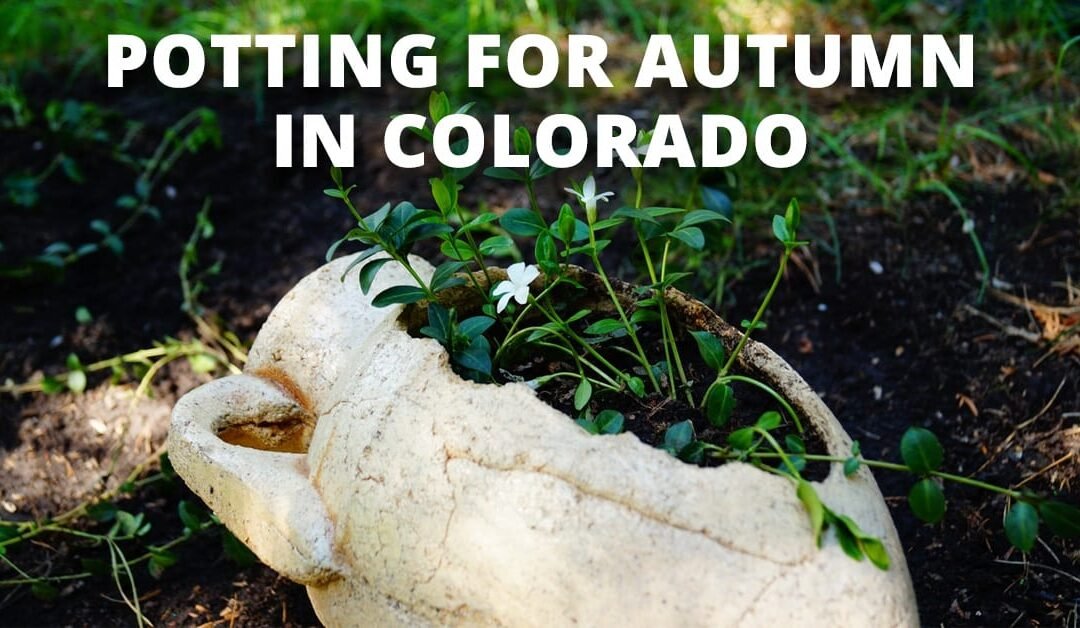As sad as it is to say goodbye to summer each year, it is just as exciting to say hello to the fall and all the glorious transformations and colors that autumn brings to Colorado. Many people believe that gardening season is over in September, but in some ways, gardening in the fall can be even more rewarding. There are many more opportunities during this time, to add fall foliage colors, utilizing suitable flowers, succulents, shrubs and small trees that thrive even when temperatures drop and the plants stop growing.
One way to spruce up your existing garden or add color to your patio, is to design various containers. There are quite a few considerations to keep in mind when potting for the fall in Colorado.
Container Types
There are many different types of containers to choose from, including clay (terra cotta), wood barrels, fiberglass planters, iron pots, planter boxes, wire baskets lined with coconut coir or sphagnum moss, colorful ceramic pots or plastic containers. Prior to choosing a container, you should determine the space where the containers will be placed for the season. Hardscape elements will stand out more prominently in your landscape because many of your existing plants will have lost their leaves in the fall. Therefore, the plants and container you choose, should compliment or match these elements such as your walkways and railings.
An additional consideration when selecting your containers would be the color of plants within a container as well as the color among the group of containers themselves. You might have color theme in mind. For example, variegated foliage can help complete a colorful container or you might have a group of different color containers in order to achieve your desired design.
Finally, when choosing your container, be sure to consider the drainage. It is difficult to grow plants successfully in soil that is continually water logged. If the container has no existing drainage holes, you should create your own drainage holes at the bottom using a drill or use a lightweight pot with drainage holes as an insert into a more decorative pot that does not have drainage holes.. Wood and clay containers are more pourous and lose moisture quickly, but are much better at allowing air to move through the root zone. You would need to water more often using the more pourous containers. You might consider spraying these with a sealant in order to protect them from the winter elements if you do not move them inside for the winter.
Container Weight and Size
Remember that when adding water to soil in a heave container, may make it too difficult to lift, so you need to plan ahead when planting large containers. You may want to consider adding them to container dollies with wheels unless you have no intention of moving them during the season. Tall plants would require a heavier container, in order to avoid tipping over.
If you would like to reduce the maintenance on your plants, try using a slightly larger container for your flowers, vegetables and herbs as the smaller the container, the less moisture they will hold, especially when the roots are crowded. We recommend 5 gallon containers for plant vegetables such as tomatoes, cabbage, cucumbers, peppers, egglant, and beans. For carrots, lettuce, beets and green onions, a 3-gallon container should work well. Most herbs grow well in containers of 1-gallon or less.
Types of Plants for the Fall

There are many plants that will thrive in the Colorado Autumn months including New Zealand flaxes, Bergenias, Pansies, Violas, Dogwood, Heuchera, Sawara Cypress, Heleniums, Heliopsis, Dusty Miller, Autumn Clematis, just to name a few. Try parsely, rosemary, basil, thyme, mint, dill for some herb gardening. You can add some annual containers for color during the fall and simply use them as compost at the end of their life.
Plants that hardy to two zones colder than yours can be left in the container through the winter months. Remember that you do not need to water as often in the fall and you should stop applying liquid fertilizer to your outdoor containers during this season as it could encourage new growth that won’t withstand the dropping temperatures. Once the soild freezes causing the roots to go dormant, you can stop watering.
Bottom line… Don’t retire your gardening tools just yet and allow your new fall blooms to make an appearance outside your h ome this year! For more information about fall gardening or for help with planning your fall landscaping, please contact us.

